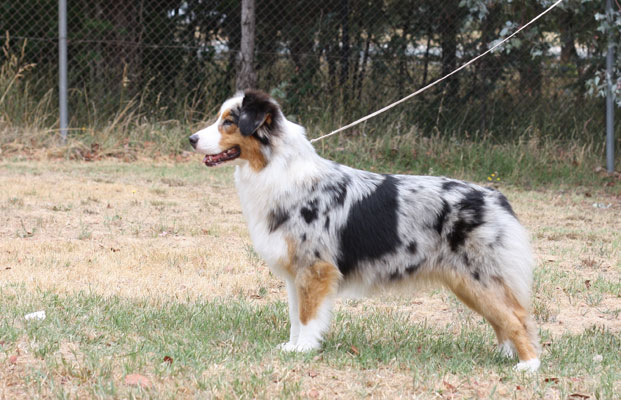
The Australian Shepherd is animated, enthusiastic and eager to please. It is a highly intelligent and dependable breed, thriving on attention and social interaction.
The Australian Shepherd enjoys being part of the family, interacting well with children and other animals. They thrive on exercise and activity, so need a reasonably sized backyard to run around in.
Boasting intelligence, strength and agility, the Australian Shepherd oozes potential and enjoys obedience, agility (including fly-ball and Frisbee) and swimming.
This breed has strong herding and guarding instincts. They can be shy and therefore reserved with strangers, but are undoubtedly loyal to the family and will certainly let you know when someone arrives.
The Australian Shepherd is healthy overall, howe’ver it goes without saying that purchasing your dog from a reputable breeder who checks for health problems reduces the risk.
The strong and dependable Australian Shepherd is a trusty working dog with a great sense of fun. Lucy Arblaster finds out why Aussies are such popular pets.
Animated, intelligent and dependable, the Australian Shepherd is a stunning breed boasting immense strength and agility, with quite a reputation as a working dog. Affectionately known as Aussies, this breed is full of potential and enthusiasm, adores children and thrives on family interaction.
Their exact origins somewhat uncertain, the Australian Shepherd is believed to have travelled to America in the late 1800s with flocks of Merino sheep and the Basque shepherds who tended them. This is also how they got their name, because of the link between Australia and the herding of Merino sheep.
In America, Australian Shepherds were used to work sheep and cattle, and while they remain a reliable working dog today, the breed also excels at obedience, tracking, agility and related activities, such as Frisbee and fly-ball, as a show dog and a very popular family companion.
A medium-sized dog with a coat of medium length, the Australian Shepherd comes in a variety of colours blue or red merle, black or red. The breed can have a long tail or naturally bobbed tail.
Some Australian Shepherds are known to grin, an endearing characteristic, which should not be mistaken for a snarl.
Breeder Susan Omundsen from the Australian Shepherd Association of NSW Inc. has been involved with the Australian Shepherd for nine years. I became friendly with a woman who had two Aussies, and it was love at first sight. They are so beautiful, clean, no smell; but what attracted me most was their sense of fun. They have an amazing sense of humour, and they’re always smiling, explains Omundsen.
Aussies take joy in the simplest things, and that joy is infectious. They are very easy to train if they want to be. You need to persuade them that training will be fun, because they certainly have their own minds and ideas about things. Like all good working dogs, they have the ability to make their own (good or bad) decisions about situations, so owners need to establish themselves as firm and loving pack leaders, says Omundsen.
Omundsen tells Dogs Life how her Aussies love nothing more than curling up with her to watch TV, or following her around the house. She says they will watch very carefully what you do.
My dogs love chasing balls, and they have evolved the game so that one dog catches the ball, then runs off and hides it. Then the others go and find it. My dogs favourite thing, however, is swimming at the beach, in the river, in waterholes. They do huge, high jumps from the rocks into their river although one bellyflops, laughs Omundsen.
Aussies are very fast and agile they can turn on a sixpence and are expert swimmers. They are great for agility, fly-ball and Frisbee. You name it, they can do it, says Omundsen.
Omundsen says Aussies are very good judges of character, summing people up immediately. I always know if they don’t like someone, because suddenly they casually insert themselves between me and the other person, says Omundsen.
Aussies will guard the home, car and people very effectively, using their bodies to stop a person advancing, and will growl ferociously. This is usually enough to stop anyone, explains Omundsen.
Aussies don’t suit the sort of person who sees a dog as something to be commanded and dominated. You need to be the boss, but if you want a dog that will obey your commands like a good little robot, an Aussie is not for you. My guys will often look up when I call and ask if they can finish what they are doing, says Omundsen.
Omundsen says if Aussies are brought up with children, they are wonderful. She says, like most dogs, if they don’t know the children and are confronted by them they are likely to be wary because children can be unpredictable. Susan says Aussies can also be shy if they are not well socialised as puppies.
My dogs love all animals. They love the neighbours horses and find birds completely intriguing. As with children, if they are brought up with other animals, Aussies are great companions, explains Omundsen.
Omundsen says Aussies have been described like jelly beans you have to have one of every colour, and once you have started with them, you wont stop. Such thinking, intelligent animals are not for everyone. They think a bit like people, and you need to think a lot like a dog to have an Aussie. They are so smart and will sometimes outsmart you you have to enjoy being made to look silly by a wriggling, grinning canine, and some people don’t, explains Omundsen.
Another admirer of the Australian Shepherd is Sydney veterinarian, Dr Rob Zammit. He has been involved with the breed for 12 years, and was initially attracted to them because of their outstanding temperament.
The Australian Shepherd overall has a great temperament. They are a very nice-looking dog, aesthetically pleasing to the eye, says Zammit. He tells Dogs Life that the Aussie is very easy-going and is not a dog that needs a lot of work. However, in saying that, he stresses that they can take the work. People have used them for working and they are great working dogs, slipping into a natural role even though, in truth, their origins still remain uncertain.
Their three best activities are agility, agility and agility. They are good to train in obedience, and during the first 12 months you think, Oh my, have I got the stupid one?, but they just take a while to click in. They have a lot of energy, but they will also lie down beside you on the lounge, explains Zammit.
He describes the breeds exercise requirements by saying, They can get away without it, but they deserve it.
Zammit says the best thing about the breed is its lack of health problems. They shed their hair twice a year, and you just need to be prepared for it. He advises keeping the feathering free from matting, especially behind their ears.
Summing the Australian Shepherd, Zammit says, They are awesome with kids (kindy age and upwards). They are a great breed of Australian dogs.
The Australian Shepherd will benefit from regular exercise and/or activity every day to keep it fit and happy. Fresh water, shelter and a well-balanced diet go without saying for this breed.
A weekly brush and a bath when necessary will keep this breeds coat in excellent condition.
Like any other breed, the Australian Shepherd should be treated for heartworm, ticks and fleas, and nails should be trimmed regularly.
For more information on the Australian Shepherd, contact your nearest club or the Australian National Kennel Council at www.ankc.org.au.
Australian Shepherd Association of NSW Inc: www.australianshepherds.org.au/
Australian Shepherd Club of Victoria Inc: www.australianshepherd.org.au/; (03) 9798 1221
Australian Shepherd Club of Qld: (07) 5546 9768
In New Zealand, please contact the New Zealand Kennel Club via www.nzkc.org.nz
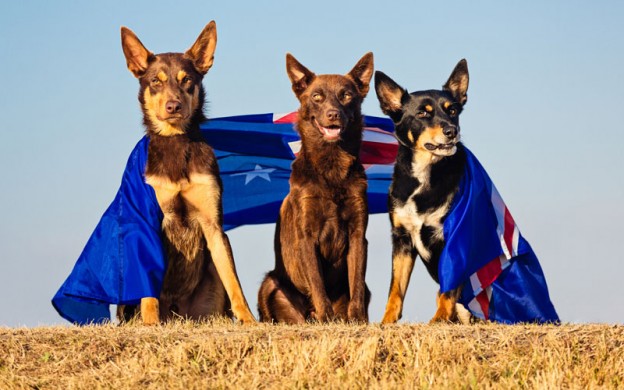
Personality: The Kelpie dog is an alert, active and friendly dog who’s devoted to his family. Hes also highly intelligent, eager to please and devoted to work.
Suitable for: An active person or family who enjoys training and spending time with their dog. The Kelpie is a devoted one-man or one-family dog and will expect to be included in the family outings!
Favourite activities: The Kelpie loves activity and enjoys flyball, agility, obedience and herding the sheep on the farm. He’ll need to be obedience-trained from a young age but will learn things pretty quickly.
Backyard requirements: The Kelpie is a true working dog and will thrive on a large property, but he’ll adapt to a large backyard as long as he has plenty of mental stimulation, such as daily walks and games. He won’t take kindly to being left in the backyard and will quickly become destructive if bored or ignored.
Watchdog qualities: While the Kelpie is a friendly breed, he can be protective of his family and property and will bark at strangers or any unusual happenings on his property.
Daily: A balanced diet and fresh water. Will need a good walk each day or plenty of games to keep his mind and body stimulated. Loves activity and will thrive given plenty of attention and exercise.
Weekly: Two brushes a week should suffice.
Monthly: Ear cleaning, nail trimming, heartworm, flea and tick treatments (if living in a tick area).
Regular: Bathe when necessary. Gastrointestinal worming and vaccinations are essential part of owing a dog.
Hereditary diseases: The Kelpie dog is a fairly hardy and healthy breed. Hip dysplasia and progressive retinal atrophy do exist in the breed. Always buy your pup from a registered breeder.
Want more articles like this? Subscribe to Dogs Life Magazine
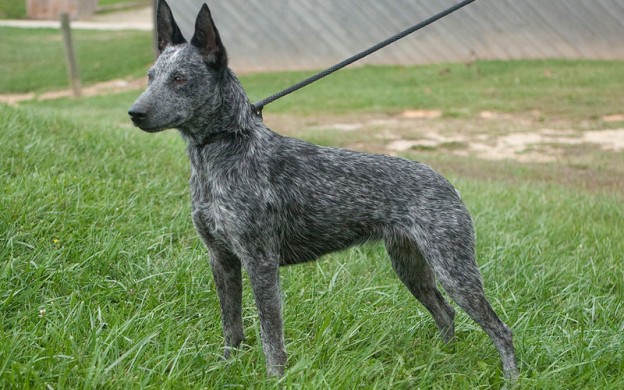
In total, three breeds were crossbred to create the Australian Stumpy Tail Cattle Dog, or “Stumpy” as it is known locally. These include the Australian dingo, the British Smithfield and the German Coolie. The Stumpy is characterized by its stumpy tail, blue coat and work ethic.
The oldest selectively bred Australian working dog, the Australian Stumpy Tail Cattle Dog is well proportioned, being square in profile with a rugged appearance. The breed comes in two varieties — blue speckled/mottled and red speckled/mottled. The Stumpy also sports a natural bob-tail up to 10cm in length. It is important to note that the tail of this breed is never docked.
Bred during the 19th century as a drover’s dog, the Stumpy is unique in Australia’s agricultural heritage. The result of mixing a Dingo with imported working dogs, this tenacious working dog was bred to move cattle over long distances, tackle harsh terrain and endure extreme temperatures.
Working dogs like the Australian Stumpy Tail Cattle Dog are known for their stamina, endurance and courage. The breed also served as a faithful and loyal mate to drovers and cattlemen. A tireless working dog and a silent worker, the Stumpy is a true ‘workaholic’. Even on the hottest day, this breed will be ready and waiting, keen for the next job on the agenda.
The Stumpy has also attracted attention overseas. America and Canada, with similarly large cattle properties, appreciate the breed’s working qualities, while it has also been exported to Japan and New Zealand. Today the Stumpy fulfils many roles — working dog, show dog, obedience dog, agility dog and constant companion. The breed is physically strong, with rugged nobility and a constant craving of activity and affection.
A South Australian breeder for more than 15 years, Kate Lewis says she was attracted to the Australian Stumpy Tail Cattle Dog because she loved its rugged look, “its musculature and its intelligence and great loyalty”.
“This is a highly intelligent dog that requires activities, both physical and mental, and a close association with its owner,” Lewis says. “They do need to have physical activity so I would not recommend them for apartment living. Preferably an active person, who can take them for a daily walk and/or swim, as they love the water.”
Lewis says they make good family pets as long as their needs for physical and mental activity are met and there are set boundaries for interaction between children and the dog. “A Stumpy, with its intelligence and loyalty, will spoil you for any other breed. Once you have been owned and loved by a Stumpy, all other breeds fail to meet your standard of a good dog. They’re not for everyone, as they can be stubborn, but they can also be your best friend and companion,” she says. Sarah Wilson of the Australian Stumpy Tail Cattle Dog Club of NSW agrees that the Stumpy is not a breed for everyone. “But if you’re chosen to be owned by a Stumpy,” she says, “you will be rewarded with a breed that has a sense of humour, great stamina, boundless energy and a mate for life.”
Personality: The Stumpy is a very loyal and hard working breed. To owners the stumpy truly is man’s best friend. A courageous dog suspicious of strangers, the Stumpy won’t give up on hard work and won’t back down from defending its owners. The obedient breed is intelligent and won’t act unless commanded to do so.
A great dog for: Farmers with cattle and energetic owners. These dogs love to work.
Favourite activities: Working, herding cattle and long daily walks.
Backyard requirements: The Stumpy is not suited to apartment living and needs a large amount of backyard space to keep energetic. The hardworking breed require a job to keep them busy. High fences are a must as the Stumpy is great at hurdles. They also love to dig and burrow if they get bored.
Grooming: The Stumpy’s coat is short and weather resistant so requires minimal grooming. They need to be bathed only when necessary and their coat groomed with a firm bristle brush. Some dogs will shed depending on their sex and the region they live.
Want more articles like this? Subscribe to Dogs Life Magazine
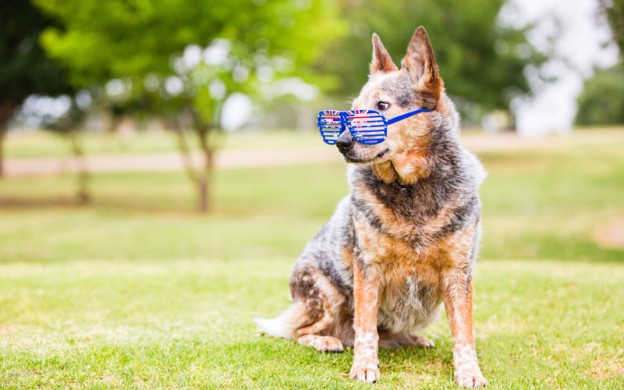
The Australian Cattle Dog breed is loyal, thrives on attention and makes a great farm dog and companion.
Personality: If you’re looking for a loyal, intelligent and energetic companion, then the Australian Cattle Dog is the dog for you. Always eager to please, no job is too big or too small for this active pooch. The breed thrives on attention, enjoys playing games and has an abundance of energy.
Suitable for: Otherwise known as the all-rounder of the dog world, the Australian Cattle Dog can still be seen working with cattle today, but their loyal qualities, medium size and love of people make them ideal household pets. Due to their energetic nature this breed is best suited to an active person or family.
Favourite activities: The Australian Cattle Dog is full of life and keen to succeed in whatever activity it puts its mind to. They love a good long walk, will chase a ball for hours on end and don’t mind getting their feet wet at the beach either. Party tricks are another talent of the Australian Cattle Dog and are a great way to stimulate the mind and impress visitors.
Watchdog qualities: Devoted to duty, the Australian Cattle Dog rates very highly as a watchdog, protective of both owner and property. This breed is wary of strangers, but not aggressive.
Hereditary disease: The Australian Cattle Dog is generally a healthy breed, however they can suffer deafness at birth, which comes from the Dalmatian connection. Make sure you buy your dog from a recommended, qualified breeder to avoid any problems.
Daily: If you are not a big fan of exercise, then the Australian Cattle Dog is not the dog for you. Bred to run up to 50km per day, exercise is very important to this breed and they need a walk or run in an off-leash dog park every day or least every other day.
Weekly: If grooming is not your thing, then the Australian Cattle Dog is the ideal companion for you. This breed has a double coat, which means they have a coarse outer coat and a dense, woolly undercoat. The double coat helps to insulate the dog from extreme heat or cold. Brushing or combing once a week should be sufficient to keep the Australian Cattle Dog in tip-top condition.
Monthly: Depending on activities and the surrounding environment, the Australian Cattle Dog needs a bath every few weeks or at least once a month to keep it looking and smelling good. Due to this breeds double coat, it should be checked regularly for ticks and should have necessary treatment for heartworm, ticks and fleas. Nails should also be checked and trimmed regularly.
Breaking the Oldest Dog record!
Did you know the Australian Cattle Dog holds the oldest dog record? Bluey the Australian Cattle Dog lived to the ripe old age of 29 years, working sheep for 20 of those years.
For more information on Australian Cattle Dog breeders and clubs in your state visit the websites of:
Australian National Kennel Council on www.ankc.aust.com
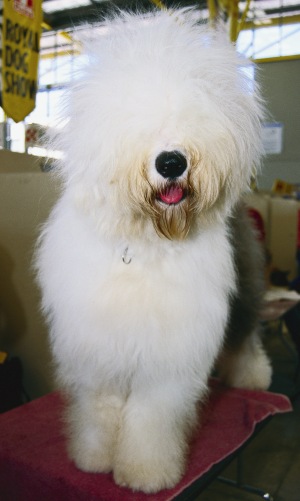
Watchdog qualities: OES are alert and protective but never aggressive. Their deep, resonant and unusual bark can be quite frightening and definitely a deterrent to anybody thinking of breaking into your home.
Personality: Old English Sheepdogs are fun-loving, boisterous, friendly, intelligent and protective. OES are strong-willed but eager to please. Early, firm and consistent training helps to curb overly boisterous behaviour. They need constant companionship and can become bored and display destructive behaviour if left alone all day. Mental and physical stimulation is a must to keep the OES content and happy.
Favourite activities: Despite their size, OES are great at agility exercises and love walks and swims when given an opportunity. They love a game or two and relish lazy days by your feet.
Suitable for: Their adaptability means they are well-suited to a number of domestic situations. OES are good with families with children aged five and above, and people who lead active lifestyles and are committed to grooming and training. They are ideal as a lone pet but also do well with other animals and pets around them.
Hereditary diseases: In general, the OES is a fairly healthy dog, but skin, eyes and hip dysplasia can be a problem. Potential owners should buy pups from breeders who have hip X-rayed and scored their breeding stock. According to OES breeder Karen Nelligan, the average hip score is 15 (zero is best, and the worst reported has been 75).
The affectionate and fun-loving Old English Sheepdog needs constant companionship and can adapt to any family lifestyle. Mei Yen Chua reports.
The Old English Sheepdog is believed to have evolved from the Bearded Collie and the Russian Owtchars in the early 1800s, but was only recognised as a distinct breed by the Kennel Club of London in 1873.
The breed was developed in the rugged south-western counties of England. The end result is a weather-resistant, double-coated, hardy dog designed for guarding, herding and protecting sheep from predators. This shaggy, lovable breed has also been made famous over the last four decades as the mascot of the paint company, Dulux.
Dogs Life learns from Pamela Ellis, NSW Club Secretary, that this distinctive, thickset Old English Sheepdog (OES) was introduced into Australia as early as the 1840 to 1870s. These sheepdogs accompanied immigrant farm workers, who were encouraged to migrate from Great Britain to seek a better life and help establish a sheep industry on the pastures west of the Great Dividing Range. The breed clubs in Australia are well-established and well-represented throughout the country.
These dogs were, and still are, affectionately known as Bobtails. Behind the nickname lies an interesting history. Back in the 1800s, English farmers were exempt from paying tax on their working dogs the way to prove this was by docking the dogs tails as a means to distinguish working dogs from pets.
Wagging their tail
The other theory behind tail docking was to prevent working dogs from fulfilling their latent need to chase game and livestock. Farmers and shepherds believed that by removing a dogs tail, it would decrease its agility and speed and prevent it being distracted by the need to chase livestock, thus making it a better herder.
The tradition of tail docking is slowly coming to an end, with most OES now able to wag their tails. The Australian government banned the docking of tails in 2003, with the exception of Northern Territory and Western Australia. So if you buy a pup, it will come with a tail.
Dogs Life speaks to Ellis and Queensland Welfare Officer and Show Secretary, Karen Nelligan, about their beloved OES. Both NSW and Qld branches have been running since the early 1970s and have a loyal band of breed enthusiasts.
Both women point out and emphasise the high level of maintenance required in caring for an OES. You must be able to devote time to grooming your dog on a daily basis. If you are not showing your dog, you may want to keep it in a short coat for practical reasons.
Matting of the dog’s coat is uncomfortable and can even be painful for the animal, Nelligan tells Dogs Life.
Many owners opt to keep their OES in a shorter haircut, which requires less attention. A good professional dog groomer can give your dog a great haircut. The dogs also become very excited and frisky after having their coat clipped. By the time winter comes around, the coat will be completely full again for protection against cold weather.
Grooming requirements
Having 30 years experience with OES, Ellis shares with Dogs Life some great grooming tips to keep the Old English Sheepdog in full coat. She informs us that brushing serves two purposes: to prevent mats forming in the coat (or remove them if they have) and to clean the coat and stimulate growth.
Brush the dog thoroughly, working in partings from the skin outwards, she says. Brush with smooth strokes without ripping and tearing at the coat. One of the most common mistakes is brushing over the top of the coat, which allows mats to form underneath. It is better to do a really thorough job less often than several rushed ones, which may leave areas untouched and inclined to mat.
Ellis says to pay attention to the eyes, as you will need to remove the accumulated sleep from them daily. If the dog is provided with good oral-care dog biscuits, the teeth will not require much in the way of maintenance. The ears need to have the hair plucked from the inside regularly or canker can result.
Ellis also reminds Dogs Life that shampoos designed for humans should not be used on dogs, as the pH in human shampoo can harm their sensitive skin. To keep your OES looking healthy and fit, Nelligan recommends feeding a combination of quality dry dog food with fresh meat and uncooked chicken bones.
Re-homing Old English Sheepdogs
Both clubs run re-homing programs, but thankfully there has been little need for it. The welfare officer is the main contact for re-homing in the Queensland club. The Old English Sheepdogs happy-go-lucky and amenable disposition means they adapt and are placed quickly with new families.
Nelligans love for the breed is almost like an addiction. She says, Once you have had one, you must always have one or more in your life. They are like big cuddly bears that are just happy to be with you. There are no words to express the love and joy that this breed brings to your life. You have not lived until you have had an OES climb up on your lap and give you a big kiss. And if you can look past the moulting of fur, wet dripping beards and constant walking across your path of travel, then the OES is the dog for you!
If youd like to see the Old English Sheepdog in action, check out the dog shows near you. For more information about events, contact you state canine council.
Daily: Daily exercise and play is recommended for this breed to keep it fit and happy. Provide lots of water and shade during the hotter months. A daily quick brushing will ensure that the woolly hair doesn’t mat and pick up unwanted debris and dirt.
Weekly: A full-coated OES will need weekly thorough brushing and grooming. OES can be bathed once a week or once every three to four weeks, depending on weather and how dirty the coat is. Dogs should be groomed before bathing, not the other way around.
Monthly: Trim hair in ear canal to avoid matting. If you don’t want to do it yourself, your vet can do it for you. Inside of the ears and under the ear flaps should be cleaned regularly with a recommended cleaning solution. Cut undercoat between the pads of the feet, behind the ears, and between the toes and the ball of the foot to avoid problems
For more information about the Old English Sheepdog, contact your state canine club or:
OES Club (New South Wales) – Puppy Inquiries & Welfare Officer Jill Clinch: (02) 4754 1226
OES Club of Queensland – Welfare Officer & Show Secretary Karen Nelligan: 0409 270 858
OWS Club of South Australia Inc. – Secretary Hugh Dennis: (08) 8264 0468
OES Club of Victoria Inc. – Secretary Denise Findlay: (03) 9561 3027
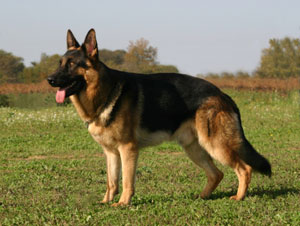
We find out some interesting German Shepherd facts, including the breed’s personality traits and interesting history.
Personality: Devoted and loyal to the core, the German Shepherd loves being part of the family and makes a wonderful companion.
Suitability: People who love spending time with their dog/s, and allow their dog/s inside the home as part of the family. The breed enjoys the company of children but like all breeds, they need to be supervised in the company of young children, especially considering their size.
Favourite Activities: The German Shepherd is great at many doggy sports and loves to have fun. Their favourite activity is spending time with their pack YOU! whether that be lying in front of the Tele, playing ball in the yard or running around the park. Whatever you are doing they want to do, too!
Watchdog Qualities: German Sheps make great guard dogs and have been used by many security organisations for this very reason. Due to their natural guarding instincts they are often used to protect property. They will certainly alert you to strangers and protect their loved ones.
Backyard Requirements: German Shepherds need regular mental and physical stimulation to stay happy. If left alone for long periods of time in a backyard they will become bored, destructive and noisy. Always leave plenty of dog-friendly chew toys or a large marrow bone at home when you are away, and practise good boredom busters (check out an issue of Dogs Life Magazine for more information on boredom.) They will live quite happily in a small to medium sized yard as long as they received the correct daily exercise.
With its noble look and natural athletic build, the German Shepherd Dog almost demands respect. Ask anyone in the company of this dignified breed and they’ll admit you cannot help but be impressed by this dogs remarkable presence.
While the German Shepherd Dog can sometimes intimidate with something as insignificant as a self-confident stare, a well-bred dog of sound temperament will prove to be not only the perfect companion, but the ideal working dog. In fact, this breed has been assisting man as far back as the 1800s when, as a working shepherd dog, it would herd sheep and keep stragglers from straying while the shepherd rested, knowing his sheep were in the best of hands.
Many people mistakenly believe the GSD was bred to be a guard dog. In fact, it was originally bred as a working/herding animal and belongs to the Working Group of dogs. Its this sort of work to which it is best suited and those who want a GSD for the sole purpose of standing sentinel outside to guard home and property are barking up the wrong tree. It is widely agreed that, as with all breeds, aggression in a GSD will be the result of poor breeding, bad or cruel handling and inappropriate or no training and socialisation. According to the experts, this breed craves human company and should not be left alone outside. Because of its herding instincts it needs to be part of a family which it can love and watch over, with supreme loyalty and dedication.
South Australian German Shepherd Dog breeder Andrew Hueppauff, first vice president of the German Shepherd Dog Club of South Australia, stresses this breed should not be bought simply to serve as a guard dog. Buy it to be part of the family, he emphasises. I have six pet GSDs, which are also our showing and breeding animals and they stay together in our yard. But when its cold outside they’re in the house with us. They are part of the family.
German Shepherd Dog breeder Lyn Gregor, whose dogs share her home on the New South Wales North Coast, agrees that this breed goes far beyond being a guard dog.
This dog is the perfect companion, she says. I have kept GSDs for about 20 years and have never known another breed that is more tuned in to people. This is a real dog and very much a people dog, completely in synch with its owner. They can read your moods.
In most states, it is now against the law to use German Shepherd Dogs for the sole purpose of guarding property. Thankfully, the days of GSDs and other guard dogs running up and down fences in the dead of night fulfilling their guarding duties are a thing of the past.
The one aspect most GSD experts agree on as possibly the breeds most popular attribute is its amazing versatility. While this dog can be the consummate playmate, its also able to do obedience, tracking and agility, as well as learn to be part of the police or lead blind people. Today, the breed is a prime player in detecting drugs and contraband, in search and rescue and in the military. As one GSD owner says, Throw anything in the way of this dog and it can do it. And in every domain it gets involved in, the German Shepherd Dog is revered for its intelligence, loyalty and courage.
But training must go hand in hand with this dogs incredible abilities, and breeders are unanimous that early obedience training is of the utmost importance in the development of all GSD pups. They have such a strong protective instinct that extensive socialisation at a young age will prevent over-protection in adult dogs.
Breeder Andrew Hueppauff recommends beginning socialisation as early as eight weeks and obedience work from 12 weeks of age. The important thing is how a dog is brought up, he says, and the way its treated at home. Start training your German Shepherd Dog as early as possible.
The GSD standard states the breed should be suitable as an all-round working, herding and service dog, but to fulfill these functions the dog needs to be of well-balanced temperament, steady of nerve, self-assured, absolutely free and easy and (unless provoked), completely good-natured as well as alert and tractable. All experts agree that early obedience training is the only way this breed can realise these goals. But while obedience training is imperative for the development of an acceptable temperament and socialisation skills, its also a stimulating and exciting pastime for this incredibly intelligent dog.
Peter Comatas is the publicity officer for the Victorian German Shepherd Dog Club and as liaison officer for the club, works closely with a number of service organisations. Peter is passionate about this breed and stresses the importance of providing German Shepherds with enough stimulation and exercise to satisfy their intelligence. He states emphatically that if you’re not prepared to provide this all-important aspect of a GSDs life, don’t buy one.
Peter also suggests that GSD owners consider entering their dogs in conformation and obedience competitions. GSDs enjoy physical exercise and their owners must be prepared to exercise them regularly, he states. A German Shepherd Dog is most happy when it has a task in life.
This breed is an excellent family dog and grows very attached to all members of the household. It is particularly good with children in the family. These dogs are easy to care for, needing a bath only once or twice a year so the oils in their skin are not depleted. Show dogs naturally need a bath before each show. Grooming can be limited to once a week but this breed does shed if its a problem, a quick brush once a day can reduce little hairs littering carpets and furniture.
German Shepherd Dogs can suffer from inherited problems which include hip and elbow dysplasia and haemophilia, so buying from a reputable breeder is paramount.
Puppies are generally not hip and elbow scored until 12 months of age so if buying a dog not yet one year old insist the pup is from hip- and elbow-scored parents. You should also ask to see a breed classification from your breeder.
The German Shepherd Dog Council of Australia, to which all state German Shepherd Dog Councils are affiliated, runs a Breed Survey Scheme to assess the health and temperament of German Shepherd Dogs nationwide, providing breed survey classifications to each dog brought along by its breeder. See the box on page 48 for more information.
The German Shepherd Dog League of New South Wales points out that the GSD has the largest number of canine registrations, reflecting the breeds popularity and usefulness. And although the GSD is used as a working dog in the army and other government services, the Leagues publicity manual says by far the largest numbers are owned by German Shepherd Dog enthusiasts as beloved family pets.
Val Moody, Secretary of the Victorian German Shepherd Dog Club, is a die-hard German Shepherd Dog enthusiast.
This has to be one of the most popular dogs around, she states.
And once you have owned one, they simply get into your blood. They are superb.
Origin
The German Shepherd Dogs ancestors were a diverse group of sheepdogs found in Germany in the late 1800s. A German cavalry captain named Max von Stephanitz known as the father of the breed had noticed the talents of these dogs and in 1899 began the first German Shepherd Dog Club of Germany. A German Shepherd Dog he recently bought became the first registered dog in the club.
The GSD grew in popularity and was reportedly being imported into Australia as early as 1904. While still used as a working and herding dog in Germany, the German Shepherd Dog began to be used in police and military forces in that country and played a major role in the German army during World War I.
World War II saw the breed fall out of favour around the world but a few years after the war ended, the dogs popularity once again surged.
In 1972 the Australian government ended a 44-year ban on the importation of German Shepherd Dogs into the country and this pooch has since gone on to become possibly the most popular breed in Australia, fulfilling vital roles in police, security and military units as well as serving as a trusted companion in thousands of Australian homes.
Due to the availability of overseas bloodlines and therefore an increase in genetic material, the breed today is much improved.
Daily: The German Shepherd enjoys daily exercise and needs a balanced diet which includes vegetables and meat, raw meaty bones and fresh water. Always leave at least half an hour or more between meals and exercise. Remember not to over-exercise your young Shep, to prevent joint problems.
Weekly: A brush once a week, more often when shedding will help keep the coat in tip-top shape.
Monthly: Ear cleaning and nail trimming. Heartworm and flea treatments.
Regular: Bath when necessary. Annual vaccinations.
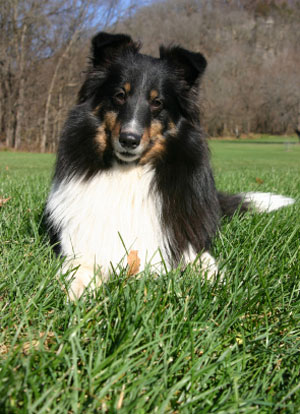
Personality: A friendly, affectionate, intelligent and alert breed, the Sheltie craves attention from family and shines when being included in the home.
Suitable for: People who will include their dog in family outings and don’t mind a weekly grooming session.
Favourite activities: Playing ball in the backyard, lounging in front of the TV or going for a walk. Whatever you are doing they want to do too!
Watchdog qualities: Shelties will look after their people and property, often warning strangers with a confident bark.
Backyard requirements: As long as Shelties are given daily exercise and attention they do not need a large backyard.
The Shetland Sheepdog originated in the 1700s from the Shetland Islands, off the coast of Scotland. Dubbed the Dwarf Scotch Shepherd and later the Shetland Collie, the breed is actually a miniature version of the large working sheepdogs of Scotland and was re-named in 1908 when the Shetland Sheepdog Club was formed in Lerwick. Shetland Sheepdogs stand approximately 14 to 15 inches at the shoulder. These days the Sheltie is rarely used as a working dog but retains many of its guarding and herding instincts.
They make an excellent companion, states Christine Hatzikiriakos, President of the Shetland Sheepdog Club of NSW Inc and fan of the breed for more than 22 years. They are very versatile and wonderful with all ages, but their dream is to jump up on the couch with you, she laughs.
An alert, gentle and intelligent dog, the Sheltie is very tolerant with young children (howe’ver like all breeds, needs to be supervised) and enjoys running around playing ball in the backyard, going for walks or lazing around in front of the TV. Basically whatever you are doing they want to be a part of, too. They are happy-go-lucky dogs, says Christine, very loving, eager to please and easygoing.
Due to their ancestors working life, Shelties also make great little watchdogs and will alert their family to strangers on the property. Christina says they are not aggressive but will stand back and bark if threatened. They are protective of their family so you must take notice when they are making noise, she stresses.
Julie Kaden, Secretary of the Collie and Shetland Sheepdog Club in Tasmania, agrees they are an excellent watchdog and do not miss much at all. They are always vigilant and will instantly alert you to anything unusual, she says. Julie has been breeding the Sheltie for some 15 years and says the perfect person for the breed is someone who has the time to spend with their dog. They have great personalities, they have their own little quirks and are real characters. I have never had two the same, she says with a smile. They are also affectionate and highly intelligent but I cannot stress enough the importance of getting your puppy socialised through puppy classes, obedience and generally getting out and about. If you do this you will have a lovely civilised dog to take walking with you.
Part of the family
Shelties shine when they feel like they belong and love getting their own gifts. Our Shelties really enjoy Christmas as they all get their own present. One of our dogs (who is no longer with us) used to know which one was his, even when we hid it, Julie recalls. He would always find the right present under the tree and would then sit and guard it so the other dogs wouldn’t go near it!
Christine has many fond memories of her dogs and says that whenever she shows them the ribbon they have just won in the ring, they grab it and walk out with the ribbon firmly in their mouth. I think they are little show offs, she laughs.
This confidence and eagerness to please means the breed does wonderfully, not only at showing, but also with other dog sports. They perform well at basic training, such as sit and stand, but they are also very easy to train for obedience and agility, says Christine.
Shelties are not just beautiful; they have brains and its just amazing to watch agility as its such a nice interaction between a person and a dog.
Due to their thick coat, Shelties require a guardian who doesn’t mind spending time grooming their dogs. They malt twice a year and this takes quite a bit of grooming, but a good bath will help to get most of the loose fur out, says Julie.
Otherwise a brush once a week, and a comb through their feathering on ears and legs, will keep them looking beautiful and knot-free.
A generally healthy and hardy breed, the Sheltie is prone to hereditary problems and care must be taken to choose a registered breeder who has taken the necessary precautions.
There are hereditary diseases in the breed such as hip dysplasia and collie eye, says Julie, so when buying a puppy always check the breeder has screened their stock, has hip scored the paren’ts and tested the pups eyes at eight weeks.
Daily: Shetland Sheepdogs love daily attention, affection and exercise. Always provide a balanced diet including fresh meat and vegetables, good-quality commercial dog biscuits, raw bones such as chicken necks/wings, and cool water.
Weekly: Their coat will need a weekly brush. They shed twice a year and at this time will need a daily groom.
Monthly: Heartworm and flea treatments. Ear cleaning and nail trimming.
Regular: Free from doggy odour, Shelties only need occasional baths but will need a bath when shedding to loosen the fur.
Hereditary diseases: Hip and eye problems speak to your vet or breeder if you would like to learn more.
Australian and NZ breed clubs and canine control councils
* Please visit the Australian National Kennel Council website www.ankc.aust.com for the phone number, website and email address of the canine control council or breed club in your state.
* For Shetland Sheepdog clubs in New Zealand please visit the New Zealand Kennel Club website on www.nzkc.org.nz
Want to know more about hereditary problems in dog breeds? Check out www.vetsci.usyd.edu/lida for a comprehensive easy to read explanations on hereditary problems for all breeds.
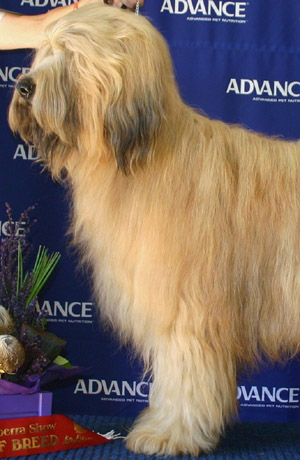
Described by Thomas Jefferson as the finest house and farm dogs I have ever seen, its clear that the Briard has much more to offer than a beautiful shaggy coat.
Bred for centuries as watch and herd dogs on remote French farms, the Briard was also the official dog of the French Army, and was used to carry supplies to the front line and served as a sentry dog. Due to the breeds keen hearing, they were also used by the medical corps to search for wounded soldiers. Unfortunately, it was this role in World War I that contributed to the Briards status as a rare breed. Many were lost as they searched bodies, looking for any sign of life. It was once said that any man a Briard passed was beyond assistance.
Today, the Briard is still an excellent guard dog, without being too vicious. With their wonderful hearing, reported to be the most acute of any breed, nothing gets by unnoticed.
One person who knows the dog only too well is Briard enthusiast Anne Mitchell. A breeder for the past 27 years, shes certainly learnt a thing or two about this intelligent canine. They bark only as a warning, but when they do, both their bark and growl can be pretty fearsome. Its certainly reassuring when you’re alone in the house at night, she says.
That’s not to say the Briard is always so brave. Mitchell recounts an amusing story about the night an unwanted visitor dropped by. We were woken up one night when one dog, JJ, let out a blood-curdling scream and launched himself onto our bed, she recalls. On investigating, we found a frog had dropped from our high ceiling right on top of him he had never moved so fast!
Getting to know you
Mitchell is the first to admit the breed isn’t for everyone. We often say that the perfect owner must be smarter than the Briard, she explains.
An intelligent breed with a streak of independence, the Briard is quick to learn, but also quick to take advantage of any lack of determination on the part of the owner. This is why the dog is suited to an active family with strong leadership qualities. Incredibly affectionate, one of the Briards greatest joys is to be with their owner. They love long walks, where they can explore ahead but continually return to check-in.
Surprisingly, the boisterous Briard also makes an excellent house dog, enjoying quiet time curled up at the feet of their owner just as much as time spent playing outside. Having said this, the Briard likes to be in on the action at all times. The greatest cruelty you can inflict on a Briard is to keep him shut outside when his family is inside, Mitchell says.
Due to its long history as a watch dog, by nature the Briard tends to be reserved with strangers. To counteract this aloofness, Briard puppies must have plenty of socialising while they are young.
This will in no way lessen their effectiveness as a guard dog. Mitchell recommends puppy preschool classes as a great way of starting the socialisation process.
Once described by a well-known actress as hearts wrapped in fur, adult Briards love children of all ages. Thanks to their extremely amiable and tolerant attitude towards children, the breed is actually known as the babysitter dog in its home country of France. In fact, people are most likely familiar with the breed from the tale Peter Pan, where the dog Nanny is featured as a devoted companion to the three Darling children. At times, however, Briard puppies can become too overwhelming for children under four to cope with, particularly when parents are first-time owners.
Looking good
We can’t really talk about Briards without mentioning their beautiful shaggy coats. With a coat 10cm or longer, ample beard and moustache hair, and a long fringe covering the eyes and ears, its obvious that the dog requires regular grooming. However, it’s not as time-consuming as some might think.
Briards don’t have a thick undercoat, and the topcoat is almost straight and fairly coarse, so they are easier and quicker to groom than many other long-coated breeds. Owners should still allow an hour or two once a week for grooming, and longer if they miss a week. Briards don’t have an annual moult, so regular grooming not only keeps the breed looking good, but minimises the amount of hair shed around the house.
To find out more about the Briard or to find a breeder, contact your state canine council via the Australian National Kennel Council (ANKC) website at www.ankc.org.au
In New Zealand, please contact the New Zealand Kennel Club via the website www.nzkc.org.nz/about.html
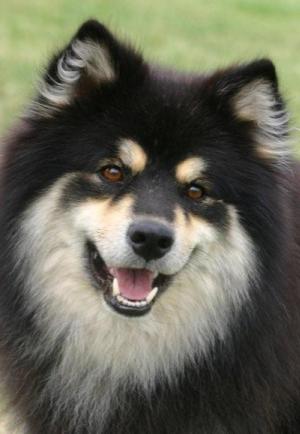
Originating in the area known as Lapland, which incorporates Sweden, Finland and parts of North Russia and Norway, the Sami people used dogs of the same type as the Finnish Lapphund as reindeer herders, watchdogs and family companions. Although used as a working dog by the Sami people for centuries, it has only been in recent times that they have been recognised as an official breed, with attempts to protect them. The first standard was established by the Finnish Kennel Club in the 1950s, with a review in 1967 splitting the breed into two – the shorter-coated Lapponian Herder and longer-coated Lapphund. The name for the longer-coated breed changed in 1993 to Finnish Lapphund.
Today, the Finnish Lapphund is a friendly, loving companion and is one of the more popular family dogs in Finland. They have only been in Australia relatively recently, the first arriving in 1995. They have tended to adopt the nickname Lappies here. The Finnish Lapphund is extremely affectionate and loyal, a fact corroborated by breeder and enthusiast Vanessa Brotto, who knows the Finish Lapphund all too well.
Finnish Lapphunds really are an all-round great dog for anyone. Their temperaments once they are grown are relaxed and gentle. They want to learn, they want to please their owners, they also very much want to be with their owners. Putting in a little effort at the beginning of a puppys life rewards you with a companion that adores you for life, Brotto tells Dogs Life. The perfect person for this breed is someone of any age who is dedicated to loving their dog and willing to spend time with it. The calm, friendly and faithful nature of this breed makes it a very suitable household companion.
A child-friendly dog
These dogs get along wonderfully with children and other animals, but early socialisation is a must. As with all breeds, children should be supervised. Finnish Lapphunds are very gentle with small children. They adore children and know to be gentle around them, although puppies and adolescents may be more boisterous, Brotto says.
They are bright, happy and friendly, and love nothing more than to join you on the couch. The breed is on average a gentle, keen and intelligent dog that adapts to humans lifestyle very quickly, she adds. Despite its gorgeous looks, the Lapphund makes a good watchdog. They will bark a lot when someone approaches your house, but do not show any aggression toward humans and will happily welcome any visitors into the house, wanted or otherwise. They are not suitable for anyone wanting a guard dog, Brotto tells Dogs Life.
This breed loves human companionship and does not adapt well to solitary life in a backyard. The Lapphund requires an average-sized backyard that is fully fenced, plus the benefit of a daily walk. They are a fairly active breed and have great stamina since they were bred for herding, but are willing to adjust to walks around the neighbourhood with their family.
A Lapphund needs attention from their owners. Not a dog to just visit once a night in the backyard. They are an ideal inside dog and companion to their human friends, Brotto says.
Oh deer!
Brotto tells Dogs Life about the Lapphunds amazing herding skills. I was sitting in my kitchen eating my breakfast when I heard my Malamutes go wild, she says. Glancing out the kitchen window I saw to my disbelief a deer milling around with the horses in the paddock behind my dogs exercise runs.
I thought Id better go and chase the deer off my property. I had seen it before; it belongs to one of my neighbours in the area. I went down to the back paddock and started shooing this deer into the front paddock, so the owner could come and get it. Gasping for breath and getting absolutely nowhere with the deer, I stopped and thought, What am I doing chasing this deer around, when I have a perfectly good example of a reindeer-herding Finnish Lapphund, barking madly in my back yard?
I went and got Blaze the Lappy and told him on the way down to the paddock what I wanted him to do. He danced around me with delight in his eyes.
When Brotto got him to the paddock, she says he stopped dead still and quivered then he took off after the horses! I called him off them and started chasing the deer myself. Watching me perform like an idiot, Blaze decided to take over and in under a minute he had the deer chased out of that paddock into the top paddock, with me puffing and panting behind him. I had one very upset deer, one very excited Lapphund and six drooling Malamutes. The deer owner came over that evening to collect him and I went off to enter Blaze in some herding trials! she says.
Great at most dog sports
The Finnish Lapphund is extremely intelligent and easy to train. Always wanting to please its owner, its a highly versatile breed to train for any dog sport, such as obedience and agility, and it has also been used overseas as a very successful tracking dog.
The Finnish Lapphunds coat is relatively easy to look after; around 30 minutes of grooming a week is required. Their coat is reasonably waterproof and any mud easily brushes out once the coat is dry. They require a bath only rarely.
They do very well in cooler climates, but cope well with the hotter weather, as long as care is taken to let them rest during the hottest part of the day and providing plenty of shady areas. As a Spitz breed, they have a full double coat, erect ears and carry their tails over their back when moving.
They come in a large range of colours, although black with various degrees of paler-coloured markings on the face and legs, is the most common. The Lapphund is quite a healthy, robust breed and has few hereditary diseases, howe’ver hip dysplasia, PRCD/PRA and cataracts can appear. Responsible breeders test for all these conditions and breed only from stock they believe will return good results.
Most breeders take time to study the bloodlines with intent of eventually breeding these problems out.
The lifespan of this breed is around 14 years. If you have the time and dedication to allow one of these admirable dogs into your home, you will be blessed with an extremely loving and intelligent companion for life.
Grooming: 2 out of 4 ticks
Exercise: 3 out of 4 ticks
Size: Medium
Lifespan: 14 years
On the Finnish Lapphund or to locate a breeder near you, please contact your state canine council on www.ankc.aust.com/Structure.html
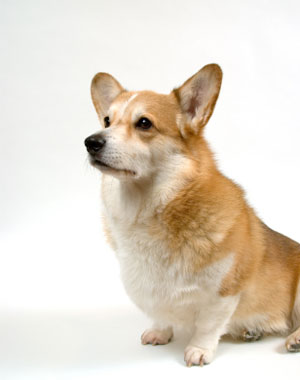
Care and exercise
A true herding dog, the Welsh Corgi Pembroke is by nature very active and likes to be kept busy, so a couple of good exercise sessions a day, whether walking or play, are recommended. This is a very intelligent little dog and responds well to training. The dense, fairly short coat needs a good brushing two or three times a week and only the very occasional bath. Twice a year the coat is shed very freely, so extra work with the comb and brush are indicated when this occurs.
Suitability
A very practical small dog eminently suited to most circumstances, the Pembroke Corgi will happily accommodate itself to even the smallest home provided it has company and sufficient exercise. A well brought up Pembroke can be an excellent playmate to all but the smallest child and certainly has proved itself over the years as the older persons companion par excellence.
Short Corgi legs mean no elaborate fencing required and the relatively easy-care coat needs little tedious grooming.
One of the all-time favourites, the Pembroke Corgi is, of course, the chosen breed of Her Majesty, Queen Elizabeth II, and these little dogs are to be found in Buckingham Palace and other Royal establishments.
Developed during the twelfth and thirteenth centuries, the breed as we now know it was perfected in and around Pembrokeshire in Wales as a hard-working cattle drover and sheepherder. It stems from the same rootstock as its cousin, the Welsh Corgi (Cardigan), the two breeds being officially separated in the 1930s.
Life is never dull with a Pembroke or two around. The appeal of this busy little dog comes from the alert interest it takes in everything going on around it and the loyalty and affection it makes obvious to its family. It is also known for its longevity. The Pembroke makes a very effective watchdog, particularly since the size of its bark belies its small stature.
With prick ears and attractive, foxy expression, lowset, sturdy, tailless body, the Pembroke has a fairly short but thick jacket that comes in red, sable, fawn, or black and tan, all with or without white markings. Averaging around 25-30cm at the shoulder, the Pembroke should weigh between 10 and 12kg. Unfortunately, many these days weigh much more than that, so feeding needs to be carefully regulated!
DogsLife is proudly powered by WordPress
